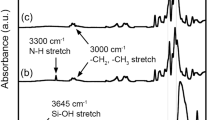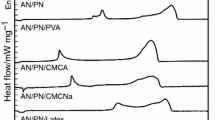Abstract
Purpose. The aim was to investigate the influence of polymer content and molecular weight on the morphology and heat- and moisture-induced transformations, as indicators of stability, of spray-dried composite particles of amorphous lactose and poly(vinylpyrrolidone) (PVP).
Methods. Amorphous lactose and composite particles of amorphous lactose with different contents and molecular weights of PVP were prepared by spray drying. The nanostructure of the particles was analyzed by x-ray powder diffractometry, the morphology by light microscopy and SEM, the glass transition temperatures (Tg), crystallization temperatures (Tc), heats of crystallization and melting temperatures by differential scanning calorimetry, and moisture-induced crystallizations gravimetrically and by microcalorimetry.
Results. All the types of particles prepared were amorphous. The Tg was unchanged or only marginally increased as a result of the inclusion of PVP. However, crystallization temperature, time to moisture-induced crystallization, and particle morphology were affected by both content and molecular weight of PVP.
Conclusions. Increased content and molecular weight of PVP may have the potential to increase the physical stability of amorphous lactose. However, Tg seems not to be a relevant indicator for the stability of this type of amorphous composite materials.
Similar content being viewed by others
REFERENCES
B. C. Hancock and M. Parks. What is the true solubility advantage for amorphous pharmaceuticals? Pharm. Res. 17:397–404 (2000).
O. I. Corrigan, E. M. Holohan, and K. Sabra. Amorphous forms of thiazide diuretics prepared by spray-drying. Int. J. Pharm. 18:195–200 (1984).
E. Fukuoka, M. Makita, and S. Yamamura. Glassy state of pharmaceuticals. II. Bioinequivalence of glassy and crystalline indomethacin. Chem. Pharm. Bull. 35:2943–2948 (1987).
T. Suzuki, K. Imamura, H. Fujimoto, and M. Okazaki. Relation between thermal stabilizing effect of sucrose on LDH and sucrose-LDH hydrogen bond. J. Chem. Eng. Japan 31:565–570 (1998).
H. Vromans, G. K. Bolhuis, and C. F. Lerk. Studies on tableting properties of lactose. VI. Consolidation and compaction of spray dried amorphous lactose. Acta Pharm. Suec. 23:231–240 (1986).
T. Sebhatu and G. Alderborn. Relationships between the effective interparticulate contact area and the tensile strength of tablets of amorphous and crystalline lactose of varying particle size. Eur. J. Pharm. Sci. 8:235–242 (1999).
B. C. Hancock and G. Zografi. Characteristics and significance of the amorphous state in pharmaceutical systems. J. Pharm. Sci. 86:1–12 (1997).
O. I. Corrigan. Thermal analysis of spray dried products. Thermochim. Acta 248:245–258 (1995).
C. A. Dunbar, N. M. Concessio, and A. J. Hickey. Evaluation of atomizer performance in production of respirable spray-dried particles. Pharm. Dev. Technol. 3:433–441 (1998).
T. Sebhatu, A. A. Elamin, and C. Ahlneck. Effect of moisture sorption on tabletting characteristics of spray dried (15% amorphous) lactose. Pharm. Res. 11:1233–1238 (1994).
O. I. Corrigan and E. M. Holohan. Amorphous spray-dried hydroflumethiazide-polyvinylpyrrolidone systems: physicochemical properties. J. Pharm. Pharmacol. 36:217–221 (1984).
O. I. Corrigan, E. M. Holohan, and M. R. Reilly. Physicochemical properties of indomethacin and related compounds co-spray dried with polyvinylpyrrolidone. Drug Dev. Ind. Pharm. 11:677–695 (1985).
M. Yoshioka, B. C. Hancock, and G. Zografi. Inhibition of indomethacin crystallization in poly(vinylpyrrolidone) coprecipitates. J. Pharm. Sci. 84:983–986 (1995).
S. L. Shamblin, S. Y. Huang, and G. Zografi. The effects of co-lyophilized polymeric additives on the glass transition temperature and crystallization of amorphous sucrose. J.Thermal Anal. 47:1567–1579 (1996).
S. L. Shamblin, L. S. Taylor, and G. Zografi. Mixing behavior of colyophilized binary systems. J. Pharm. Sci. 87:694–701 (1998).
L. S. Taylor and G. Zografi. Sugar-polymer hydrogen bond interactions in lyophilized amorphous mixtures. J. Pharm. Sci. 87:1615–1621 (1998).
T. Matsumoto and G. Zografi. Physical properties of solid molecular dispersions of indomethacin with poly(vinylpyrrolidone) and poly(vinylpyrrolidone–co-vinyl-acetate) in relation to indomethacin crystallization. Pharm. Res. 11:1722–1728 (1999).
S. L. Shamblin and G. Zografi. The effects of absorbed water on the properties of amorphous mixtures containing sucrose. Pharm. Res. 16:1119–1124 (1999).
H. Takeuchi, T. Yasuji, T. Hino, H. Yamamoto, and Y. Kawashima. Temperature-induced crystallization and compactability of spray dried composite particles composed of amorphous lactose and various types of water-soluble polymer. Chem. Pharm. Bull. 48:585–588 (2000).
H. Takeuchi, T. Yasuji, T. Hino, H. Yamamoto, and Y. Kawashima. Temperature-and moisture-induced crystallization of amorphous lactose in composite particles with sodium alginate prepared by spray-drying. Pharm. Dev. Technol. 5:355–363 (2000).
X. M. Zeng, G. P. Martin, and C. Marriott. Effects of molecular weight of polyvinylpyrrolidone on the glass transition and crystallization of co-lyophilized sucrose. Int. J. Pharm. 218:63–73 (2001).
M. Gordon and J. S. Taylor. Ideal copolymers and the second-order transitions of synthetic rubbers. I. Non-crystalline copolymers. J. Appl. Chem. 2:493–500 (1952).
B. C. Hancock and G. Zografi. The relationship between the glass transition temperature and the water content of amorphous pharmaceutical solids. Pharm. Res. 11:471–477 (1994).
G. Buckton. Isothermal microcalorimetry water sorption experiments: calibration issues. Thermochim. Acta 347:63–71 (2000).
D. Brandon and W. D. Kaplan. Microstructural characterisation of materials, John Wiley&Sons, London, 1999.
T. Sebhatu, M. Angberg, and C. Ahlneck. Assessment of the degree of disorder in crystalline solids by isothermal microcalorimetry. Int. J. Pharm. 104:135–144 (1994).
Author information
Authors and Affiliations
Rights and permissions
About this article
Cite this article
Berggren, J., Alderborn, G. Effect of Polymer Content and Molecular Weight on the Morphology and Heat- and Moisture-Induced Transformations of Spray-Dried Composite Particles of Amorphous Lactose and Poly(vinylpyrrolidone). Pharm Res 20, 1039–1046 (2003). https://doi.org/10.1023/A:1024462306941
Issue Date:
DOI: https://doi.org/10.1023/A:1024462306941




